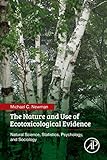The nature and use of ecotoxicological evidence : natural science, statistics, psychology, and sociology / Michael C. Newman.
Material type: TextLanguage: English Publication details: London, United Kingdom : Academic Press is an imprint of Elsevier, c2018Description: xvii, 279 pages : illustrations (some color) ; 23 cmContent type:
TextLanguage: English Publication details: London, United Kingdom : Academic Press is an imprint of Elsevier, c2018Description: xvii, 279 pages : illustrations (some color) ; 23 cmContent type: - text
- unmediated
- volume
- 9780128096420 (pbk.)
- RA1226 N46 2018
| Item type | Current library | Collection | Call number | Materials specified | Status | Notes | Date due | Barcode |
|---|---|---|---|---|---|---|---|---|
 Books
Books
|
Ladislao N. Diwa Memorial Library Reserve Section | Non-fiction | RUS RA1226 N46 2018 (Browse shelf(Opens below)) | Room use only | 78004 | 00078951 |
Includes bibliographical references and index.
Section 1. Introduction -- The emerging importance of pollution -- Section 2: How individuals gather and judge evidence -- Human reasoning: everyday heuristics and foibles -- Human reasoning: within scientific traditions and rules – Pathological reasoning within sciences -- Individual scientist: reasoning by the numbers -- Section 3: How groups weigh and apply evidence -- Social processing of evidence: commonplace dynamics and foibles -- How innovations enter and move within groups -- Evidence in social networks -- Section 4: Conclusion -- Conclusion.
"The Nature and Use of Ecotoxicological Evidence: Natural Science, Statistics, Psychology, and Sociology carefully examines how toxicologists and environmental professionals come to understand and make decisions about possible harm from pollutants. Misreading evidence by the scientific community and miscommunication to regulators and the public remain major impediments to prudent action in pollution issues. What evidence comes to dominate the dialogue among scientists, regulators, and decision makers depends on social, as well as scientific, dynamics. Yet psychological and sociological factors that influence the movement of evidence through scientific communities to regulators receive cursory discussion by professionals unfamiliar with the sociology literature.
Drawing on concepts and techniques from the natural, social, and mathematical sciences, The Nature and Use of Ecotoxicological Evidence: Natural Science, Statistics, Psychology, and Sociology emphasizes how pollutant-related evidence is gathered, assessed, communicated, and ultimately applied in decision-making. Each chapter begins with an open-ended real-world example before fundamental cognitive, social, statistical, or natural science concepts are explored and used to explain the opening example. Methods from other disciplines for recognizing, reducing, or removing the influence of impediments in wise decision-making are highlighted at the end of each chapter. Toxicologists, environmental scientists, psychologists, professionals, and students across the sciences will find the materials useful for understanding how evidence is generated, assessed, and communicated in their own fields.
Key Features
Includes groundbreaking research synthesizing information from across the sciences to understand the decision-making process.
Provides real-life examples and uses theoretical concepts to analyze them in clear, direct language.
Encourages critical thinking about complex problems."--Back cover
Fund 164 Mind Mover Publishing House, Inc. Purchased 10/24/2019 78004 NEJ PHP 5,118.40 2019-10-819 2019-1-0683

